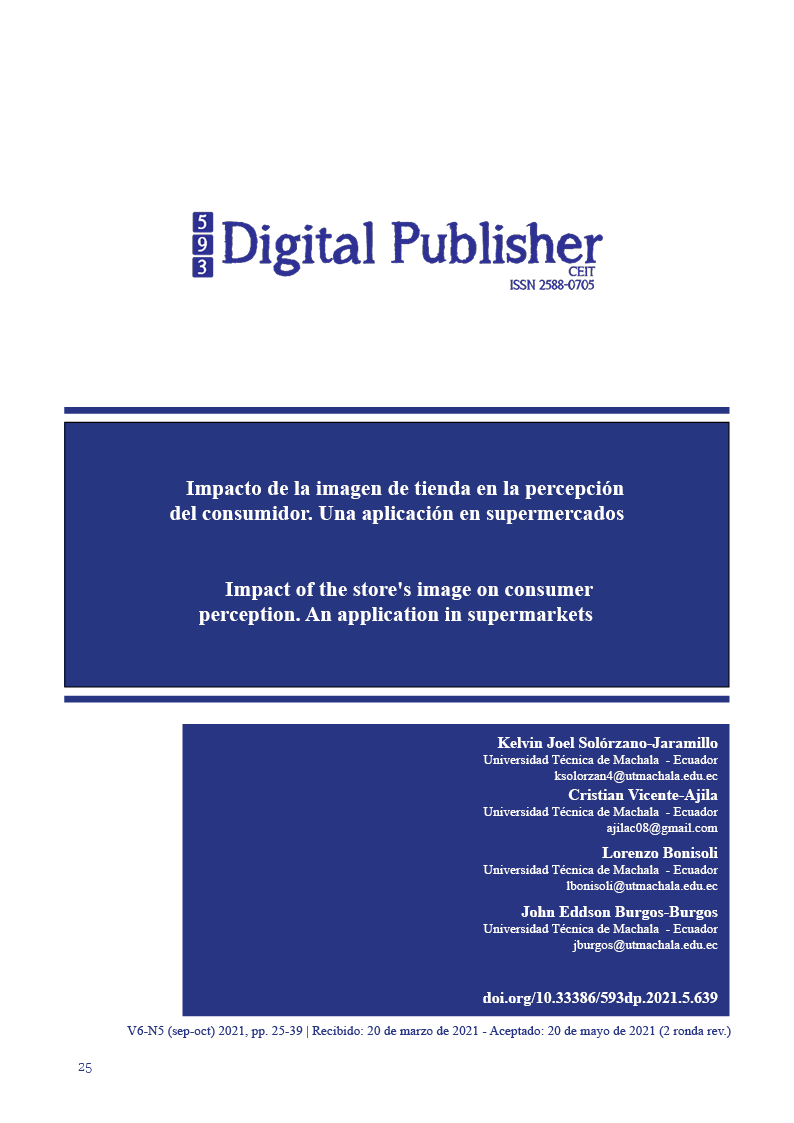Impact of the store's image on consumer perception. An application in supermarkets
Main Article Content
Abstract
The present study explains the evaluation of consumers on the impact that the store image has through their perception, the objective of the research is based on examining through an investigative model the relational significance of the study variables, the research uses a quantitative methodology with correlation range to, with a sample of 265 supermarket customers. As a result of this research carried out, very favorable results could be obtained, which verify the effects that the constructs have on each other, significant evaluations were obtained, concluding that the administration of the store image is very well managed by the supermarkets in the city of Machala.
Downloads
Article Details

This work is licensed under a Creative Commons Attribution-NonCommercial-ShareAlike 4.0 International License.
1. Derechos de autor
Las obras que se publican en 593 Digital Publisher CEIT están sujetas a los siguientes términos:
1.1. 593 Digital Publisher CEIT, conserva los derechos patrimoniales (copyright) de las obras publicadas, favorece y permite la reutilización de las mismas bajo la licencia Licencia Creative Commons 4.0 de Reconocimiento-NoComercial-CompartirIgual 4.0, por lo cual se pueden copiar, usar, difundir, transmitir y exponer públicamente, siempre que:
1.1.a. Se cite la autoría y fuente original de su publicación (revista, editorial, URL).
1.1.b. No se usen para fines comerciales u onerosos.
1.1.c. Se mencione la existencia y especificaciones de esta licencia de uso.
References
Aghekyan-Simonian, M., Forsythe, S., Suk Kwon, W., Chattaraman, V., 2012. The role of product brand image and online store image on perceived risks and online purchase intentions for apparel. J. Retailing Consum. Serv. 19 (No.3), 325–331.
Baker, J., Parasuraman, A., Grewal, D., Voss, G.B., 2002. The influence of multiple store environment cues on perceived merchandise value and patronage intention. J. Market. 66 (No 4), 120–144.
Barroso, C., Cepeda, G., & Roldan, J. L. (2005). Investigar en economía de la empresa ¿partial least squares o modelos basados en la covarianza? In J. L. Roldan (Ed.), XIX Congreso Anual y XV Congreso Hispano Francés de AEDEM (pp. 1–10). Sevilla - España: Universida de Sevilla Departamneto de Economía de Empresas.
Becker, J. M., Klein, K., & Wetzels, M. (2012). Hierarchical Latent Variable Models in PLS-SEM: Guidelines for Using Reflective-Formative Type Models. Long Range Planning, 45, 359–394. https://doi.org/10.1016/j.lrp.2012.10.001
Beneke, J., Brito, A., Barvey, K.A., 2015. Propensity to buy private label merchandise. Int. J. Retail Distribut. Manag. 43 (No 1), 43–62.
Borges, A., Babin, B.J., Spielmann, N., 2013. Gender orientation and retail atmosphere: effects on value perception. Int. J. Retail Distrib. Manag. 41 (No 7), 498–511.
Burlison, J., Oe, H., 2018. A discusión framework of store image and patronaje; a literatura review. Int. J. Retail Discussion framework of store image and patronaje: a literatura reviw. Int, J. Retail Distrib. Manag. 46 (No 7), 705-724.
Cepeda, G., Henseler, J., Ringle, C., and Roldán, J. L. (2016). Prediction-oriented modeling in business research by means of PLS path modeling: Introduction to a JBR special section. Journal of Business Research, 69, 4545–4551. https://doi.org/10.1016/j.jbusres.2016.03.048
Chang, E. C., y Tseng, Y. F. (2013). Research note: E-store image, perceived value and perceived risk. Journal of business research, 66(7), 864-870.
Chi, H.K., Huery, R.Y., Ya, T.Y., 2009. The impact of brand awareness on consumer purchase intention: the mediating effect of perceived quality and brand loyalty. J. Int. Manag. Stud. 4 (No 1), 135–144.
Chin, W. W. (2010). How to Write Up and Report PLS Analyses. In Handbook of Partial Least Squares (pp. 655–690). https://doi.org/10.1007/978-3-540-32827-8
Chin, W. W., Marcolin, B. L., and Newted, P. R. (2003). A Partial least Squares Latent Variable Modeling Approach For Measuring Interaction Effects: Results From a Monte Carlo Simulation Study and Voice Mail Emotion/Adoption Study. Proceedings of the Seventeenth International Conference on Information Systems, 21–41. https://doi.org/10.1287/isre.14.2.189.16018
CHOWDHURY, J., REARDON, J. y SRIVASTAVA, R. (1998): “Alternative modes of measuring store image: an empirical assessment of structured versus unstructured measures”, Journal of Marketing Theory and Practice, Vol. 6, nº 2, pp. 72-87.
Cornelius, B., Natter, M., Faure, C., 2010. How storefront displays influence retail store image. J. Retailing Consum. Serv. 17 (No 2), 143–151.
Cronin, J.J., Brady, M.K., Hult, G.T.M., 2000. Assessing the effects of quality, value and customer satisfaction on consumer behavioural intentions in service environments. J. Retailing 76 (No 2), 193–218.
Diallo, M.F., Burt, S., Sparks, L., 2015. The influence of image and consumer factors on store brand choice in the Brazilian market. Eur. Bus. Rev. 27 (No 5), 494–512.
Echeverría Ríos, O. M., y Medina-Quintero, J. M. (2016). Imagen de Marca en la Percepción de la Calidad del Consumidor de los Vehículos Compactos. Investigación administrativa, 45(117), 0-0.
Edward G., C., and Zeller, R. A. (1999). Realiblity and validity assessment. SAGE Publication Ltd.
Erdil, T.S., 2015. Effects of customer brand perceptions on store image and purchase intention: an application in apparel clothing. Procedia – Soc. Behav. Sci. 207,196–205.
Fornell, C., and Larcker, D. (1981). Structural Equation Models with Unobservable Variables and Measurement Error: Algebra and Statistics. Journal of Marketing Research, 18, 382–388.
Fuentes Blasco, M., Moliner Velázquez, B., Servera Francés, D., & Gil Saura, I. (2020). ¿Cómo varían los efectos de la innovación en el comercio minorista? Un análisis por categoría de producto. DOI: 10.5295/cdg.191081mf
Graciola, A. P., De Toni, D., Milan, G. S., and Eberle, L. (2020). Mediated-moderated effects: High and low store image, brand awareness, perceived value from mini and supermarkets retail stores. Journal of Retailing and Consumer Services, 55, 102117.
Grewal, D., Monroe, K.B., Krishnan, R., 1998. The effects of price-comparison advertising on Buyers, perceptions of acquisition value, transaction value and behavioral intentions. J. Market. 62 (No 2), 46–59.
Hu, L., & Bentler, P. (1999). Cutoff criteria for fit indexes in covariance structure analysis: conventional criteria versus new alternatives. A Multidisciplinary Journal, 6(1), 1–55
Huang, R., Sarigollu, E., 2012. How brand awareness relates to market outcome, brand equity, and the marketing mix. J. Bus. Res. 65 (No 1), 92–99.
Hutter, K., Hautz, J., Dennhardt, S., Füller, J., 2013. The impact of user interactions in social media on brand awareness and purchase intention: the case of Mini on Facebook. J. Prod. Brand Manag. 22 (No 5/6), 342–351.
Instituto Nacional de Estadísticas y Censos (INEC), 2020, htpps://www.ecuadorencifras.gob.ec/empleo-septiembre-2020/,obtenido el 25 de febrero de 2021
Jinfeng, W., Zhilong, T., 2009. The impact of selected store image dimensions on retailer equity: evidence from 10 Chinese hypermarkets. J. Retailing Consum. Serv. 16 (No 6), 486–494.
Jones, M.Y., Vilches-Montero, S., Spence, M.T., Eroglu, S.A., Machleit, K.A., 2010. Do Australian and American cosumers differ in their perceived shopping experiences? A bi-cultural analysis. Int. J. Retail Distrib. Manag. 38 (No 8), 578–596.
Keller, K.L., 1993. Conceptualizing, measuring, and managing customer-based brand equity. J. Market. 57 (No 1), 1–22.
Kent, A.M., e Kirby, A.E., 2009. The design of the store environment and its implications for retail image. Int. J. Retail Distrib. Manag. 19 (No 4), 457–468.
Kim, D.K., Kim, M., 2016. Influence of brand awareness and brand atitude on purchase. J. Market. 3 (No 1), 16–26.
Kirby, A.E., Kent, A.M., 2010. Architecture as brand: store design and brand identity. J. Prod. Brand Manag. 19 (No 6), 432–439.
Kumar, A., Kim, Y.K., 2014. The store-as-a-brand strategy: the effect of store environment on customer responses. J. Retailing Consum. Serv. 21 (No 5), 685–695. https://doi.org/10.1016/j.jretconser.2014.04.008
Lin, L.Z., Yeh, H.R., 2013. A means-end chain of fuzzy conceptualization to elicit consumer perception in store image. Int. J. Hospit. Manag. 33 (No 1), 376–388.
Malhotra, N.K., Birks, D., Wills, P., 2012. Marketing Research: Applied Approach, fourth ed. Pearson, New York, NY.
Martineau, P., 1958. The personality of the retail store. Harv. Bus. Rev. 36 (No 1), 47–55.
Mazursky, D., Jacoby, J., 1986. Exploring the development of store images. J. Retailing 62 (No 2), 145–165.
Mittal, A., Mittal, R., 2008. Store choice in the emerging Indian apparel retail market: an empirical analysis. J. Retailing 77 (No 2), 21–46.
Morschett, D., Swoboda, B., Foscht, T., 2005. Perception of store attributes and overall attitude towards grocery retailers: the role of shopping motives. Int. Rev. Retail 15 (No 4), 423–447.
Norfarah, N., Koo, P.M., Siti-Nabih, A.K., 2018. A private label brand purchase intention: a Malaysia study. Glob. Bus. Manag. Res.: Int. J. 10 (No 1), 197–219.
Pan, Y., & Zinkhan, G. M. (2006). Determinants of retail patronage: a meta-analytical perspective. Journal of retailing, 82(3), 229-243.
Piris, Y., Guibert, N., 2015. Effects of intuitive judgments on consumer assortment evaluations. J. Consum. Market. 32 (No 3), 137–144.
Polanco, V. R. O. (2017). Gestión de la imagen corporativa de organizaciones universitarias desde el enfoque del marketing emocional. CIENCIAMATRIA, 3(5), 150-171. http://dx.doi.org/10.35381/cm.v3i5.19
Ponte, E.B., Carvajal-Trujillo, E., Escobar-Rodríguez, T., 2015. Influence of trust and perceived value on the intention to purchase travel online: integrating the effects of assurance on trust antecedents. Tourism Manag. 47, 286–302.
Ringle, C., Wende, S., and Becker, J. M. (2015). SmartPLS 3.3 Boenningstedt. Programa Estadístico SmartPLS. Retrieved from http://www.smartpls.com
Schlittgen, R., Ringle, C. M., Sarstedt, M., & Becker, J. M. (2016). Segmentation of PLS path models by iterative reweighted regressions. Journal of Business Research, 69, 4583–4592. https://doi.org/10.1016/j.jbusres.2016.04.009
Sharifi, S.S., 2014. Impacts of the trilogy of emotion on future purchase intentions in products of high involvement under the mediating role of brand awareness. Eur. Bus. Rev. 26 (No 1), 43–63.
Streukens, S., and Leroi-Werelds, S. (2016). Bootstrapping and PLS-SEM: A step-by-step guide to get more out of your bootstrap results. European Management Journal, 34(6), 618–632. https://doi.org/10.1016/j.emj.2016.06.003
Valkenburg, P.M., Buijzen, M., 2005. “Identifying determinants of young children’s brand awareness: television, parents, and peers”. J. Appl. Dev. Psychol. 26 (No 4), 456–468.
Van Der Vyver, J., 2008. “The Importance of Store Image Dimensions in Apparel”, Mester Degree. Stellenbosch University, 175 pp.
Villafañe, J. (2004), La gestión profesional de la imagen corporativa, Madrid, Ediciones Pirámide.
Wang, L.C., Chang, L.H., Wysong, S., 2012. An empirical investigation of the influence of optimum stimulation levels in retailing. Int. J. Retail Distrib. Manag. 40 (No 1), 6–20.
Wang, X., Yang, Z., 2010. The effect of brand credibility on consumers’ brand purchase intention in emerging economies: the moderating role of brand awareness and brand image. J. Global Market. 23 (No 3), 177–188.
Watanabe, E.A. De M., 2014. “A influencia da cultura no comportamento do consumidor de supermercados”, Brasília: UNB, 2014. Tese (Doctor degree in Business Administration). University of Economics, Administration and Accounting, University of Brasília.
Watanabe, E.A. De M., Torres, C.V., Alfinito, S., 2019. The impact of culture, evaluation of store image and satisfaction on purchase intention at supermarkets. Rev. Gestao 26 (No 3), 256–273.
Yoo, B., Donthu, N., Lee, S., 2000. An examination of selected marketing mix elements and brand equity. J. Acad. Market. Sci. 28 (No 2), 195–211.
Zeithaml, V.A., 1988. Consumer perceptions of price, quality and value: a means-end model and synthesis of evidence. J. Market. 52 (No 3), 2–22.
Zielke, S., 2006. “Measurement of retailers’ price images with a multiple-item scale”. Int. Rev. Retail Distrib. Consum. Res. 16 (No 3), 297–316.
Zielke, S., 2010. How price image dimensions influence shopping intentions for different store formats. Eur. J. Market. 44 (No 6), 748–770.
Zielke, S., Toporowski, W., 2012. Negative price-image effects of appealing store architecture: do they really exist? J. Retailing Consum. Serv. 19 (No 5), 510–518.





